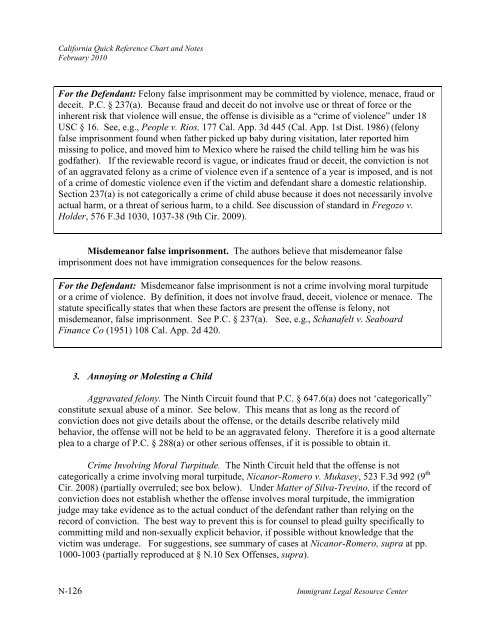quick reference chart and notes for determining immigration - ILRC
quick reference chart and notes for determining immigration - ILRC
quick reference chart and notes for determining immigration - ILRC
Create successful ePaper yourself
Turn your PDF publications into a flip-book with our unique Google optimized e-Paper software.
Cali<strong>for</strong>nia Quick Reference Chart <strong>and</strong> Notes<br />
February 2010<br />
For the Defendant: Felony false imprisonment may be committed by violence, menace, fraud or<br />
deceit. P.C. § 237(a). Because fraud <strong>and</strong> deceit do not involve use or threat of <strong>for</strong>ce or the<br />
inherent risk that violence will ensue, the offense is divisible as a “crime of violence” under 18<br />
USC § 16. See, e.g., People v. Rios, 177 Cal. App. 3d 445 (Cal. App. 1st Dist. 1986) (felony<br />
false imprisonment found when father picked up baby during visitation, later reported him<br />
missing to police, <strong>and</strong> moved him to Mexico where he raised the child telling him he was his<br />
godfather). If the reviewable record is vague, or indicates fraud or deceit, the conviction is not<br />
of an aggravated felony as a crime of violence even if a sentence of a year is imposed, <strong>and</strong> is not<br />
of a crime of domestic violence even if the victim <strong>and</strong> defendant share a domestic relationship.<br />
Section 237(a) is not categorically a crime of child abuse because it does not necessarily involve<br />
actual harm, or a threat of serious harm, to a child. See discussion of st<strong>and</strong>ard in Fregozo v.<br />
Holder, 576 F.3d 1030, 1037-38 (9th Cir. 2009).<br />
Misdemeanor false imprisonment. The authors believe that misdemeanor false<br />
imprisonment does not have <strong>immigration</strong> consequences <strong>for</strong> the below reasons.<br />
For the Defendant: Misdemeanor false imprisonment is not a crime involving moral turpitude<br />
or a crime of violence. By definition, it does not involve fraud, deceit, violence or menace. The<br />
statute specifically states that when these factors are present the offense is felony, not<br />
misdemeanor, false imprisonment. See P.C. § 237(a). See, e.g., Schanafelt v. Seaboard<br />
Finance Co (1951) 108 Cal. App. 2d 420.<br />
3. Annoying or Molesting a Child<br />
Aggravated felony. The Ninth Circuit found that P.C. § 647.6(a) does not ‘categorically”<br />
constitute sexual abuse of a minor. See below. This means that as long as the record of<br />
conviction does not give details about the offense, or the details describe relatively mild<br />
behavior, the offense will not be held to be an aggravated felony. There<strong>for</strong>e it is a good alternate<br />
plea to a charge of P.C. § 288(a) or other serious offenses, if it is possible to obtain it.<br />
Crime Involving Moral Turpitude. The Ninth Circuit held that the offense is not<br />
categorically a crime involving moral turpitude, Nicanor-Romero v. Mukasey, 523 F.3d 992 (9 th<br />
Cir. 2008) (partially overruled; see box below). Under Matter of Silva-Trevino, if the record of<br />
conviction does not establish whether the offense involves moral turpitude, the <strong>immigration</strong><br />
judge may take evidence as to the actual conduct of the defendant rather than relying on the<br />
record of conviction. The best way to prevent this is <strong>for</strong> counsel to plead guilty specifically to<br />
committing mild <strong>and</strong> non-sexually explicit behavior, if possible without knowledge that the<br />
victim was underage. For suggestions, see summary of cases at Nicanor-Romero, supra at pp.<br />
1000-1003 (partially reproduced at § N.10 Sex Offenses, supra).<br />
N-126 Immigrant Legal Resource Center

















